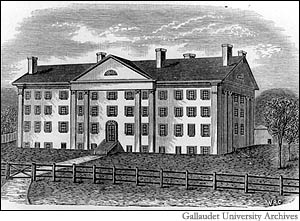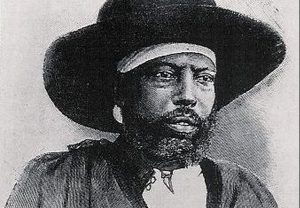During the 1800s, deaf people in America had no language they could use to communicate with other deaf people, or anyone else for that matter. They let others know their needs and wants through gestures and signs they came up with on their own. Some basic gestures, such as “yes” or “hungry,” were somewhat universal, but those signs only scratched the surface of what deaf people wanted to say. They were in need of their own language and of a way and a place to learn it, and although he was not deaf or hard of hearing, a man named Thomas Hopkins Gallaudet was the one who finally acquired it for them.
Thomas Gallaudet was a man of many talents. After graduating from Yale at seventeen, he worked as a law assistant and a tutor, but due to health-related issues, he left his job and became a door-to-door salesman in rural Kentucky and Ohio, where he schooled young children that couldn’t afford an education. He especially enjoyed teaching geography, U.S. history, and the Bible, which eventually lead to him discovering his own passion for religion. He earned his license to be a preacher, and became a traveling minister, going everywhere he felt there was a need. His constant traveling allowed him to visit his family in his hometown of Hartford, Connecticut on a regular basis.1

During one of his visits home, Gallaudet came across his neighbor’s daughter, Alice Cogswell, playing by herself. At the age of two, Alice had contracted meningitis, and as a result, lost her hearing.2 Her father, Dr. Mason Fitch Cogswell, explained to Gallaudet that his daughter was deaf and that she had trouble communicating with not only other children but also with her own family. Knowing that Gallaudet was a teacher, Dr. Cogswell pleaded with Gallaudet to help Alice learn how to speak, regardless of whether it was with her voice or her hands.3
Gallaudet agreed, and started teaching a simple form of sign language as best as he could. Nevertheless, both Gallaudet and Dr. Cogswell were deeply concerned with the lack of deaf education in America and set out to change that. The two them collected donations and support from their community, and soon enough, they had sufficient funds to send Gallaudet to Europe, to track down a sign language teacher.4
During his travels, Gallaudet came across an advertisement for a speech given by Abbe Sicard, the principal of a deaf institution in Paris, France. Gallaudet had previously known about him and his work, so he attended one of his speeches. After the speech, Gallaudet approached Sicard, and spoke to him about his troubles and worries over deaf education in America. Sicard listened intently to his woes and made the decision to invited Gallaudet to the institution he taught at, to take lessons under him. Gallaudet zealously accepted the offer, and went off to Paris with Sicard.5
In addition to taking classes with Sicard, Gallaudet also took private lessons with Sicard’s chief assistant, Laurent Clerc. Gallaudet was entranced by Clerc’s expertise in the sign language and begged him to come to America to teach with him. Clerc was skeptical, but Gallaudet was adamant. He worked hard to get Clerc onboard with his plan. Clerc eventually gave in and sought permission from Sicard to take a leave for his journey to America. Sicard was also initially wary of Clerc’s expedition, but also came around to the idea and granted Clerc the permission he asked for.6

On June 18, 1816, Gallaudet and Clerc set out for Hartford, Connecticut on the ship Mary Augusta, a journey that lasted fifty-two days. The two men used that time to exchange their knowledge of languages. Clerc continued teaching Gallaudet the vast array of signs that were included in French Sign Language, and Gallaudet helped Clerc to polish his English-speaking skills. On August 22, 1816, the day the Mary Augusta arrived in America, Laurent Clerc met Alice Cogswell for the first time. Although she did not know French Sign Language, Clerc “communicated with her through sign associations.” Clerc saw Alice had a strong will to continue to learn sign language, which fueled him in his quest to teach the deaf people of America a standardized nonverbal form of communication.7
Over the next couple of months, Gallaudet and Clerc traveled the United States. They spread information about sign language and deaf culture, met with potential students and their parents, and they began the process of establishing the first deaf school in America. They collected funds by taking donations from the public and from the Connecticut General Assembly also. They raised over $15,000 and they used that money to start what was “originally called the Connecticut Asylum at Hartford for the Instruction of Deaf and Dumb Persons (now the American School for the Deaf).”8 On the day of April 15, 1817, a little less than a year since Gallaudet brought Clerc to the United States, the school opened its doors to the public. Laurent Clerc was the first teacher and Alice Cogswell was the first student. The French Sign Language Clerc taught to his students eventually evolved to the dialect that deaf Americans still use today, American Sign Language.9

Although the school was good, Gallaudet and Clerc wanted to keep going. They went to Congress and got approval from the House of Representatives, Senate, and President Abraham Lincoln to granted college degrees from their school. Eventually, the American School for the Deaf branched out to form Gallaudet University, the first and only all-deaf university in the United States.10 Both the American School for the Deaf and Gallaudet University continue to provide proper education to those who are deaf and hard of hearing, proving a saying that prevails in deaf culture: Deaf people can do EVERYTHING a hearing person can do except hear.
- Katalin Enders, “Gallaudet, Thomas Hopkins,” 2003, Learning to Give (website), https://www.learningtogive.org/resources/gallaudet-thomas-hopkins. ↵
- “Alice Cogswell,” Scholastic. April/May 2012. ↵
- Carolyn Ball, The History of American Sign Language Interpreting Education (Minnesota: Capella University, 2007), 11. ↵
- Loida R. Canlas, “Laurent Clerc: Apostle to the Deaf People of the New World,” 2015, Gallaudet (website), http://www3.gallaudet.edu/clerc-center/info-to-go/deaf-culture/laurent-clerc.html. ↵
- Margret A. Winzer, The History of Special Education: From Isolation to Integration (Washington D.C.: Gallaudet University Press, 1993), 101. ↵
- Margret A. Winzer, The History of Special Education: From Isolation to Integration (Washington D.C.: Gallaudet University Press, 1993), 101. ↵
- Loida R. Canlas, “Laurent Clerc: Apostle to the Deaf People of the New World,” 2015, Gallaudet (website), http://www3.gallaudet.edu/clerc-center/info-to-go/deaf-culture/laurent-clerc.html. ↵
- Loida R. Canlas, “Laurent Clerc: Apostle to the Deaf People of the New World,” 2015, Gallaudet (website), http://www3.gallaudet.edu/clerc-center/info-to-go/deaf-culture/laurent-clerc.html. ↵
- Marc Marschark and Patricia E. Spencer, Oxford Handbook of Deaf Studies, Language, and Education (Oxford: Oxford University Press, 2003), 13-14. ↵
- Loida R. Canlas, “Laurent Clerc: Apostle to the Deaf People of the New World,” 2015, Gallaudet (website), http://www3.gallaudet.edu/clerc-center/info-to-go/deaf-culture/laurent-clerc.html. ↵



61 comments
Samantha Zamorano
This article shows just how much power educators have! Gallaudet’s tenacity and ambition for wanting to help deaf people is amazing. Thank you for mentioning ‘deaf culture’ as it passes my mind that this is a culture I myself know entirely nothing about. I will say I was a little taken aback by the original name of the American School for the Deaf. I’m going to look into when the ‘dumb person’ part was dropped, or when the name was changed entirely. Overall, I am glad someone like Gallaudet took an interest in bettering a society for a community that he didn’t necessarily belong to. Had it not been for him, I wonder how long it would’ve taken for people to get past the skepticism and prejudice of teaching deaf people how to communicate.
Nooraldeen Aldrees
Very interesting article, and important topic. Sometimes I wish that I communicate with sign language. I believe it is less dramatic and defiantly afford quieter environment. A question for you: when Thomas Gallaudet start teaching Alice, you mentioned that he started teaching simple sign language. Was that simple language based on some rules or just an improvised signal that varies from an individual to another? I ask this because I want to know if there was a foundation for sign language in the US at the time, and Gallaudet helped to refine it through opening a school for it?
It is amazing how Mr. Gallaudet traveled all the way to France to improve sign language in the US. What language do you think he used to communicate with? Did they use English, French, or Latin? Also, why do you think the French had a school for the sign language while at that time most countries did not? Was there is a particular incident that inspired the French to open a sign language school? I am sorry to ask lots of question. It is just very interesting how things develop..
Nydia Ramirez
I have always been interested in the origins of ASL as well as learning myself. I had known about Gallaudet University but never looked into the history attached to it. I loved your article because it provided valuable insight on just who exactly Thomas Gallaudet was. What caught my eye was the long process including the traveling between countries. This truly exemplifies Thomas’s passion and determination. I am so glad he consistently met his goals because hard of hearing schools are extremely necessary. I would have loved to know more about the process behind the University establishment for example what went on in the different branches of government. I feel like in this point in time we should have already established more.
Nooraldeen Aldrees
Yazmin,
Very interesting article, and important topic. Sometimes I wish that I communicate with sign language. I believe it is less dramatic and defiantly afford quieter environment. A question for you: when Thomas Gallaudet start teaching Alice, you mentioned that he started teaching simple sign language. Was that simple language based on some rules or just an improvised signal that varies from an individual to another? I ask this because I want to know if there was a foundation for sign language in the US at the time, and Gallaudet helped to refine it through opening a school for it?
It is amazing how Mr. Gallaudet traveled all the way to France to improve sign language in the US. What language do you think he used to communicate with? Did they use English, French, or Latin? Also, why do you think the French had a school for the sign language while at that time most countries did not? Was there is a particular incident that inspired the French to open a sign language school? I am sorry to ask lots of question. It is just very interesting how things develop.
Alexa Montelongo
I have been practicing ASL for awhile now and this was a great and informative article. I can’t help but notice that not every school has a class to learn ASL. It feels that we are still leaving the deaf community out of society as our education system does not make the effort to include an ASL class in all districts. Gallaudet only started the work that needs to be completed, and that is making sure every school has the opportunity to include the deaf community.
Sofia Almanzan
Great Article. I have always loved deaf culture because it is interesting and evolving. I have attempted to learn sign language and want to one day be fluent. I didn’t know that it started in the 1800’s which makes sense because I have seen the revival of the musical Spring Awakening that is a twist that shows deaf culture and the struggle many deaf people had to go through because people would not let them use ASL.
Ana Cravioto Herrero
I never thought about how sign language came about but this is very interesting! It is very inspiring to learn about how it took a group effort, and how many people supported them on their mission to make a language that was suitable for the hard of hearing so that they could communicate properly. It is sad to think about how many deaf people were not able to get their thoughts across properly, even with their own family, and it is sad because I bet that still happens today even with the established language.
Melissa Garza
Amazing and very informative read! I have always wanted to learn sign language because I think it would be very beneficial. What Gallaudet did for deaf people is amazing and I’ve never heard his story before. I never even knew the origin of American Sign Language so it was really great to finally learn about it. It must have been so difficult to communicate before American Sign Language and I cannot even begin to imagine what they went through.
Carlos Apodaca
What Thomas Gallaudet did for the deaf was very incredible and beneficial for the deaf community because it allowed for them to the community around them. I enjoyed reading the history behind Gallaudet’s journey in helping the deaf people and learning sign language, he was able to bring that to the United States and spread it across America which eventually lead to what we have today where people can take classes at school and learn sign language.
Jake Mares
Interesting topic and article! I have never before heard of well anyone in this story. Being deaf in those times must have been an impossible struggle with a viewpoint from today. Now, we have all sorts of potential services for helping disabled, but back then, as the article says, there was little to no assistance. I could not even imagine the struggle of going through not being able to communicate to others around me.